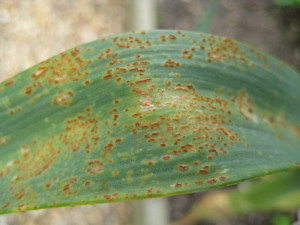There are endless types of rust affecting a huge number of plants, this article is aimed specifically at Allium rust (puccinia porri) affecting leeks, garlic,onions,shallots and chives.
Prevention
Once your plants are infected with rust there is no cure and although you may be able to harvest them you may have a substantial reduction in yield and storage ability.Therefore prevention is the only way to tackle rust long term.
If you have suffered with rust its always a good policy to replant in a fresh part of your garden.
The first signs of infection will be:
Rust On leaves
Bright orange pustules on both sides of infected leaves. These are initially enclosed by the surface tissues of the leaf, but break open to release dusty, orange, airborne spores.
The commonest allium to be infected is leeks and it is commonly called ‘leek rust
Chives especially can harbor rust as they are grown as perennials in mild areas
Lifecycle
The most important factor in the lifecycle of rust is that it cannot live on dead plant matter so must either alternate with a different, perennial host, or produce resting spores to pass the dormant season.
Mid Spring/Early Summer
When temperatures begin to rise in mid spring to early summer rust spores are released form infected living plants which land on other plants and infect them. The ideal temperature range for spore release and germination is 10°C to 20°C / 50°F to 68°C although it will still occur outside of these ranges. Spores are transferred by wind and rain drops.
Summer/Autumn
When the spores land on a suitable plant they germinate. Rust fungus then infects the new plant and begins to feed on it. The time between the spores infecting a plant and the visible signs of the infection appearing can be as short as a week but as long as a month. It all depends on the temperature and humidity levels.
It’s important to realise that infected plants may not always show immediate signs of infection. The infection easily spreads form one part of the plant to another (and to nearby plants) over the summer and autumn
Winter
In winter, as the temperature falls, the infection rate slows down, the fungus effectively overwinters on infected living plants, leeks especially because they are quite capable of living through winter and well into the next year.
Growing conditions
Increasing levels of Potassium available to the plant you will increase the strength and vigour in the leaves of the plant and improve resistance to weather conditions and disease. Sulphate of Potash hand hoed in around the plants in February can have a positive effect, this fertiliser provides your plants with a booster feed of potassium.
Be careful not to damage bulbs during hoeing.
Sulphur or Dithane
Regular spraying or watering with sulphur compounds or Dithane (Chemical option) will give some protection.
An application of Sulphur helps curb rust infestations in garden plants. Some Sulphur preparations are sprinkled or dusted on the plant as a powder and others are mixed with water and sprayed on the plant or poured on the soil around the base of the plant. Read the package instructions carefully and apply as indicated.
Sulfur fungicide products can be purchased online or from a garden supplies specialist.
By using an organic fungicide, you can rest assured, knowing that rust on your plants is being controlled without the use of toxic, synthetic chemicals.
Summary
- Rust thrives in humid conditions and this can be minimised by growing plants at the recommended distances apart. Crowding the plants restricts airflow which in turn increases humidity.
- Rust does better when plants are in low levels of sunlight. This causes the foliage grow “soft” which is good for rust. To avoid this grow plants which can be affected in full sunlight positions.
- Rust prefers lush foliage and this is encouraged by the application of nitrogen fertilisers so use them sparingly if at all
- Rust cannot live on dead plant matter so ensure that all parts of onions, garlic ,leek and chives are removed from the soil in autumn when crops are harvested
Each month at Learn How To Garden Dot Com we'll publish a monthly video sharing gardening tips, how-to-dos and what-to-dos. Only subscribers will get access to these exclusive videos - all it will cost is your email address!
Please fill in your name and email address below and hit the submit button. You will get an email telling you when the latest Newsletter is available and notices of any new videos.


